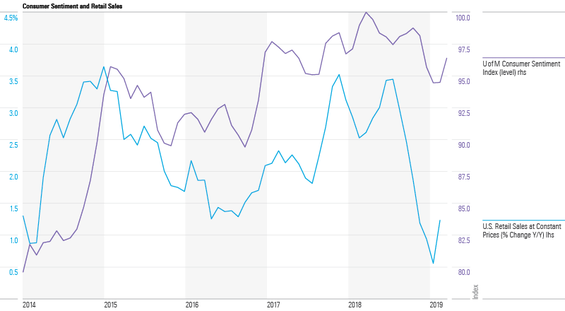U.S. stock markets experienced a strong rebound in the first quarter of 2019, following the previous quarter’s correction; however, the global impact of the turnaround has been weaker.
Every quarter, Morningstar’s quantitative research team reviews the most recent global market trends in finance and evaluates the performance of individual asset classes. The findings are then shared in the Morningstar Markets Observer, a publication that draws on quantitative analysts’ careful research and market insights.
Below, see some of the chief findings from this quarter’s review.
6 trends from the latest quarterly market update:
- Expectations for major policy rates declined. In first-quarter 2019, the Fed, the European Central Bank, and the Bank of England all lowered their market expectations for the path of policy rates (shown on the chart below). The three central banks revised down their growth forecasts, though they noted that upside inflation risks have recently softened. The Fed and ECB policymakers also explicitly lowered their guidance on the likely path of monetary policy: Neither institution’s forecast includes expectations of rate increases in 2019, and implied rates on futures contracts show rate increases are also unlikely in 2020.

- Global trade may be nearing the trough. Though the outlook for global trade remains gloomy, there are indicators that the pace of slowdown may be moderating. As the chart below illustrates, Chinese manufacturers’ export orders showed signs of bottoming in first-quarter 2019. And while U.S. and German exporters have continued to see a drop in new orders, their overall pace remains near the averages set in the aftermath of the 2008-09 financial crisis. However, the future of these numbers is subject to how U.S.-China trade tensions play out.

- U.S. retail sales decline, though elevated sentiment and a strong labor market indicate a coming rebound. As shown below, late 2018 and early 2019 saw U.S. retail-sales growth plunge to its slowest pace since 2014, which aligns with the overall economic slowdown in those quarters. Nonetheless, a strong labor market and easing financial conditions have led to an overall favorable macroeconomic environment. Similarly, U.S. consumer sentiment remains elevated around 96, which suggests a bounceback in household spending may be on the horizon.

- Morningstar fund category Bear Market saw top performance. Funds from the Bear Market and Latin America Stock Morningstar Categories experienced the highest performance in first-quarter 2019. The Bear Market Category also earned the highest-trailing 1-year returns (7.2%), which is particularly noteworthy, as most other categories experienced negative-trailing 1-year returns.

- Continued decline in costs. Multiple factors have contributed to overall falling costs, such as fund companies lowering expenses on existing funds, high-cost funds leaving the market, assets shifting to lower-cost funds, and newer, lower-cost funds entering the market. As shown below, although asset-weighted expenses for both equity and fixed-income funds have fallen nearly 30 basis points since 1994, costs have been declining because the expense ratios of individual funds have hovered around zero since then.

- Funds with below-average assets saw the most launches, while above average saw the most closures. As shown below, funds with lower-than-average assets accounted for most of the year’s launches: 382 out of 1,049. Alternatively, fund closures saw a more even spread across asset sizes, though funds with average, above average, and high assets contributed to the lion’s share of closures.

Overall, though the rebound of U.S. stock markets has led to a substantial lift for equity markets, the economic data remains mixed. This leaves continued uncertainty as to whether the upswing is backed by real economic growth.

